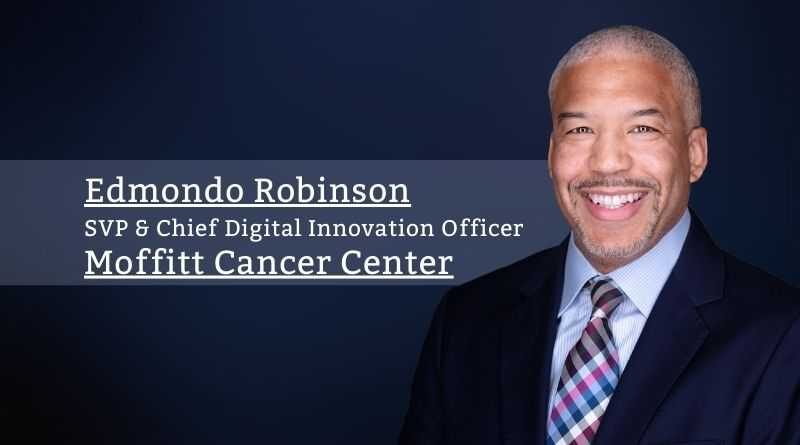Digital Innovation Accelerates Advancements in Cancer Care
By Edmondo Robinson, MD, MBA, FACP, SVP & Chief Digital Innovation Officer, Moffitt Cancer Center
Innovation in health care delivery has been in the spotlight recently. Although the practice of medicine has long been about innovation, the endless pursuit of improving patient outcomes through advancements in care and treatment and the wide dissemination of those innovations have proved to be relatively slow at times. In oncology, there has been a large investment in the research and development of novel tools and therapeutics, and the dissemination of those new innovations may move a bit faster. That has not always proved to be true when innovation is examined through the lens of health care consumerism, the acknowledgment of the need to address consumer-centric aspects of care, including convenience, access, and transparency. The COVID-19 pandemic may have changed that.
As innovations developed in response to the pandemic continue to evolve, Moffitt Cancer Center’s focus now includes digital innovation and harnessing it to improve patient outcomes and experience while also leveraging digital to accelerate research and discovery and drive down health care costs.
With cancer being such a complex and diverse set of diseases, we know digital advancements will play a significant role in the breakthroughs of the future.
Increasing Innovation during a Pandemic
In the wake of COVID-19, the pace of innovation in health care delivery was necessarily accelerated. Health care organizations across the country were forced to fast-track future technology and quickly put it into motion. “Five years of innovation taking place in five months” has been a common refrain in the industry.
At the cancer center, we understood that our patients represent one of the most vulnerable populations in the setting of a global pandemic. Moreover, our patients could not afford to have lapses in care, treatment, or screening. Knowing this, we aggressively accelerated components of our digital innovation strategy.
The first order of business was to scale our infrastructure to ensure our team members could work from home if they were not required for direct clinical care or onsite research and support services. Hardware, software, remote access, and cybersecurity infrastructure were all assessed, deployed, and expanded in a matter of weeks.
For clinical care, it was a matter of days before we relaunched our virtual visit program, providing patients access to care from the safety and comfort of their homes. Oncology is a complex field of medicine, requiring much of the treatment to be conducted in person. Before the pandemic, virtual visits were only done occasionally and under certain circumstances. But with the necessity brought on with the pandemic, we found that our providers were able to successfully continue care for existing patients or begin care for new patients through new virtual visit models. In the first few weeks of the pandemic, Moffitt’s volume of virtual visits increased by over 5,000 percent.
Another way Moffitt prioritized its patients’ safety and comfort was introducing a curbside clinic — the first health care center in Florida to offer this service.
Moffitt’s curbside clinic affords patients the ability to drive up to the clinic and receive certain treatments without stepping outside their vehicles. This gives patients peace of mind and limits exposure for those who are immunocompromised. Supported by advances in technology and a multidisciplinary team, our highly trained nurses and staff can administer many treatments to patients in the comfort of their car.
Improving the Patient Experience
The necessities required to respond to the pandemic presented an opportunity to reassess the strategic approach to health care consumerism and the patient experience. Throughout the health care industry, we have all found that we need to take a closer look at our services and see how we can better meet patient needs in the “new normal” and beyond.
One project at Moffitt that took root during the pandemic will transform the patient experience for years to come by connecting a new patient with a cancer expert within one business day of scheduling their first appointment. It is not uncommon that a patient may wait days to weeks for their first appointment at the nation’s largest cancer research centers. That wait time and the fear of the unknown can be agonizing in the face of a cancer diagnosis and are inconsistent with a truly consumer-centric approach.
Through this new program, a patient will be connected with an expert on their care team within a day to begin their personalized treatment journey — even before they ever step foot on a Moffitt campus. This optimized workflow will soon be combined with improved clinical data gathering and expanded physical access points to scale the impact of our mission to prevent and cure cancer.
Accelerating Beyond the Pandemic
It is critical that healthcare organizations, including cancer centers, take the time to refresh their strategies in light of the transformations brought on by the pandemic. It should not be enough to just have survived as an organization. The goal should be to accelerate out of the pandemic with renewed strategy and focus. For Moffitt, digital innovation sits at the foundation of our refreshed strategy. We understand that to get further in our fight against cancer, we must enhance and expand our digital ecosystem.
Our goal has always been to provide patients with comprehensive and personalized cancer care to have the best outcomes possible. With cancer being such a complex and diverse set of diseases, we know digital advancements will play a significant role in the breakthroughs of the future. Artificial intelligence (AI) will continue to grow as a critical tool touching all aspects of cancer care from back-end business operations to augmentation of clinical decision-making processes and optimization of clinical trial matching for cutting-edge clinical interventions.
Consumerism will also continue to play an important role in ongoing strategy. It is critical that we focus on building an optimized consumer digital ecosystem that provides an efficient and effective experience much more consistent with how consumers interact with services in such industries as retail and travel.
In a post-COVID world, it is clear that many of our innovations are here to stay. We are now looking to build on our long-term strategies and expand our digital tools and technologies with additional enhancements that meet our patients’ needs. Out of our learnings through the pandemic, we were able to look at our corporate strategy and make the changes needed to accelerate to the next level. Leveraging digital innovation will allow us to care for more patients, providing them with an enhanced experience and improved outcomes.



